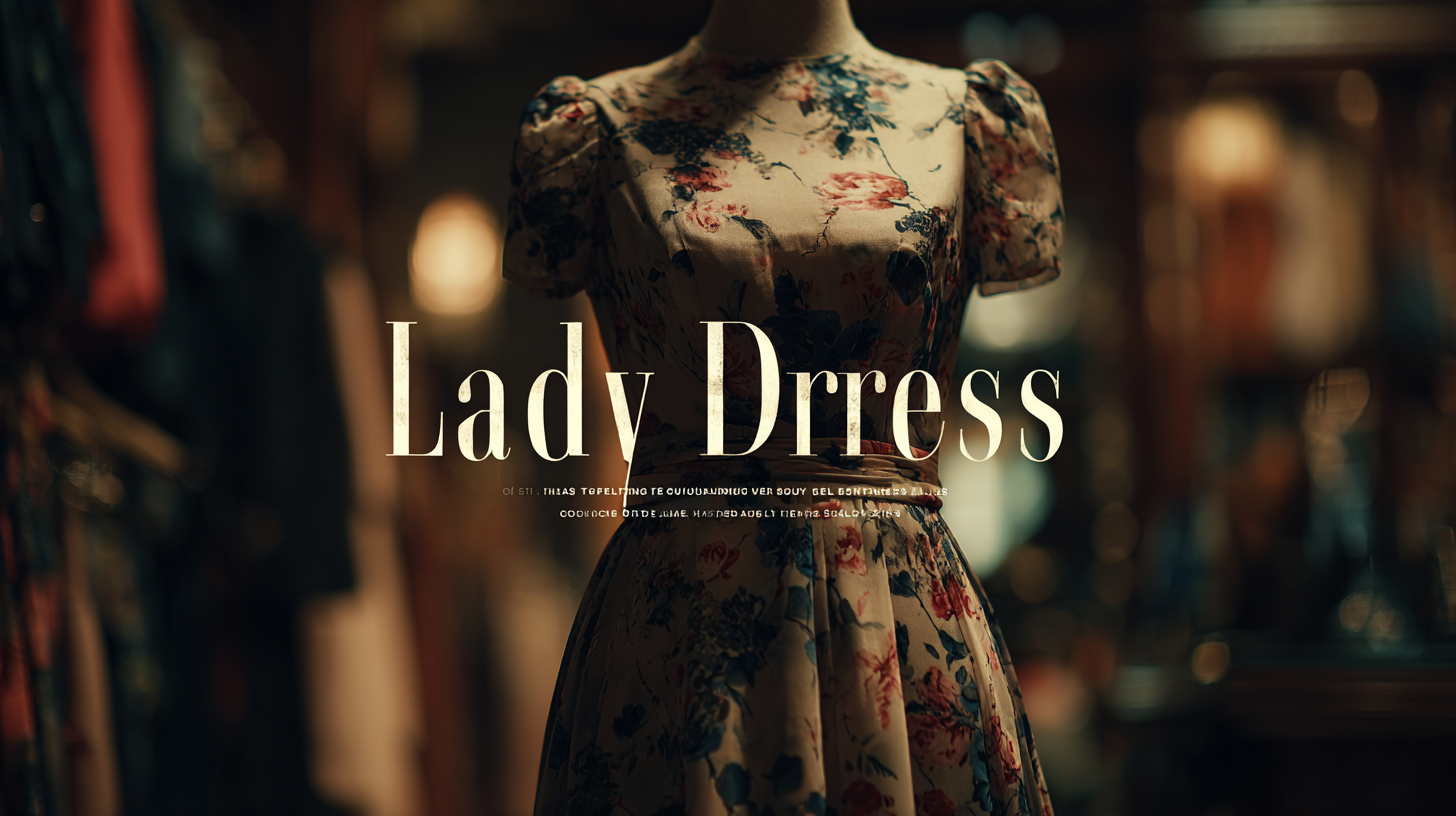Welcome to the TopShow!Garment manufacturing !
OEM, ODM Service,Custom color Custom logo,Custom Your Own Brand Online!
Welcome to the TopShow!Garment manufacturing !
OEM, ODM Service,Custom color Custom logo,Custom Your Own Brand Online!
In the ever-evolving fashion landscape, sourcing the best Lady Dress trends has become crucial for global buyers aiming to stay ahead in a competitive market. According to a recent report by the Fashion Retail Institute, the women's apparel sector is projected to grow by 4.4% annually, with dresses emerging as a key category driving this growth. This surge is fueled by increasing consumer demand for versatility, sustainability, and contemporary designs that cater to diverse body types and preferences. Additionally, insights from the Global Dress Trends Report highlight the importance of adaptability in designs, with 65% of consumers prioritizing multi-functional pieces that transition seamlessly from day to night. As fashion buyers seek to curate collections that resonate with today’s eco-conscious and style-savvy consumers, understanding these trends becomes imperative for successful sourcing decisions.

In today's fast-paced fashion industry, identifying key global markets for women's dress trends is crucial for buyers looking to curate the perfect collection. As we dive into different regions, it's essential to understand cultural influences and consumer preferences that shape trends. For example, in Europe, sustainability continues to gain traction, with consumers gravitating towards
eco-friendly materials and ethical production practices. This shift not only highlights the need for innovative designs but also emphasizes a commitment to responsible sourcing.

Meanwhile, in the Asia-Pacific region, vibrant colors and bold patterns dominate the landscape, reflecting the region's rich cultural heritage. Buyers should pay attention to emerging markets like Southeast Asia, where a youthful demographic is eager to experiment with fashion. Additionally, e-commerce has become a driving force, enabling global consumers to access diverse styles from around the world. By recognizing these regional characteristics and trends, global buyers can better navigate the complex world of women’s dress sourcing and stay ahead in a competitive market.
When sourcing the latest lady dress trends, one crucial aspect global buyers must consider is evaluating the manufacturing standards among top exporting factories. High-quality production is essential not just for aesthetics but also for ensuring durability and compliance with international standards. Buyers should prioritize factories that adhere to strict quality control processes and are certified by recognized industry standards, such as ISO or WRAP.
**Tip:** When visiting factories, request to see documentation of their quality assurance processes. This helps confirm their commitment to maintaining high standards throughout the production cycle.
Another key factor is the ethical practices within these factories. As consumers become increasingly aware of sustainable fashion, it’s essential to partner with factories that focus on fair labor practices and environmentally friendly production methods. This not only enhances brand reputation but also aligns with the growing demand for responsible sourcing.
**Tip:** Conduct factory audits and communicate with previous clients to gain insights into the supplier's ethical practices. This ensures that the manufacturing partner reflects your brand's values and meets the expectations of conscientious consumers.
| Factory Location | Manufacturing Capability | Quality Certifications | Average Lead Time | Sustainability Practices |
|---|---|---|---|---|
| Vietnam | 100,000 units/month | ISO 9001, OEKO-TEX | 30 days | Use of recycled materials |
| Bangladesh | 120,000 units/month | WRAP, ISO 14001 | 45 days | Water-saving techniques |
| China | 200,000 units/month | BSCI, ISO 9001 | 20 days | Sustainable energy initiatives |
| Turkey | 80,000 units/month | GOTS, ISO 14001 | 35 days | Biodegradable packaging |
| India | 90,000 units/month | SA8000, OEKO-TEX | 50 days | Fair trade practices |
 Sustainable practices in global dress manufacturing have become essential as consumers increasingly demand environmentally friendly choices. Brands are now adopting ethical sourcing and production methods to reduce their carbon footprint. This includes using organic fabrics, such as cotton and linen, which not only diminish the reliance on harmful pesticides but also promote healthier ecosystems.
Furthermore, many companies are turning to recycled materials, transforming waste into fashionable garments that contribute to a circular economy.
Sustainable practices in global dress manufacturing have become essential as consumers increasingly demand environmentally friendly choices. Brands are now adopting ethical sourcing and production methods to reduce their carbon footprint. This includes using organic fabrics, such as cotton and linen, which not only diminish the reliance on harmful pesticides but also promote healthier ecosystems.
Furthermore, many companies are turning to recycled materials, transforming waste into fashionable garments that contribute to a circular economy.
In addition to material choices, sustainability in dress manufacturing extends to the production process itself. Implementing energy-efficient technologies and reducing water consumption during manufacturing are critical steps that minimize environmental impact. Brands are also exploring local production options to shorten supply chains, which not only decreases transportation emissions but also supports local economies. By prioritizing transparency and traceability in their sourcing practices, global buyers can ensure that their chosen brands align with their values and contribute positively to the planet's well-being.
Understanding consumer preferences is crucial for navigating the dynamic landscape of the ladies’ dress market. Shifts in trends, influenced by social media, celebrity endorsements, and cultural movements, have made it essential for global buyers to stay attuned to what resonates with different demographics. Modern consumers are increasingly seeking styles that not only reflect the latest fashion trends but also align with their values, such as sustainability and ethical production. Therefore, understanding the nuances in style preferences—be it boho-chic, professional attire, or athleisure—is key to sourcing dresses that appeal to various markets.
Moreover, demographic factors play a significant role in shaping consumer preferences. Younger generations, particularly Millennials and Gen Z, tend to gravitate towards brands that offer a sense of individuality and inclusivity. They prioritize versatility and comfort without sacrificing style, which has led to a surge in demand for casual yet fashionable dresses. In contrast, older demographics may prefer classic styles that combine elegance and practicality. By leveraging data analytics and consumer feedback, global buyers can effectively tailor their collections to meet these diverse preferences, ensuring they remain relevant and competitive in the ever-evolving ladies’ dress market.
As we navigate the ever-evolving landscape of fashion, innovative fabrics and design trends emerge as pivotal elements shaping future collections for ladies' dresses. According to the latest market research from Allied Market Research, the global women’s apparel market is projected to reach $1 trillion by 2025, driven by an increasing demand for sustainable and versatile materials. Sustainable fabrics such as organic cotton, Tencel, and recycled polyester are not only redefining luxury but are also addressing consumer concerns about environmental impact.
In the realm of design, the shift towards personalization and inclusivity has never been more pronounced. A report by McKinsey & Company highlights that 70% of consumers are more likely to buy a product if it’s personalized to their preferences. This has led brands to incorporate innovative design elements like modular outfits and adjustable sizing, catering to a diverse customer base. Designers are leveraging technology such as 3D printing and digital prototyping to create unique pieces that not only empower women but also resonate with their individual styles. As buyers seek dresses that embody both fashion-forward thinking and sustainability, these trends set the stage for a vibrant future in women's fashion.
This chart illustrates the fabric preferences among global buyers for lady dresses in 2023, highlighting the shift towards more innovative and sustainable materials.
